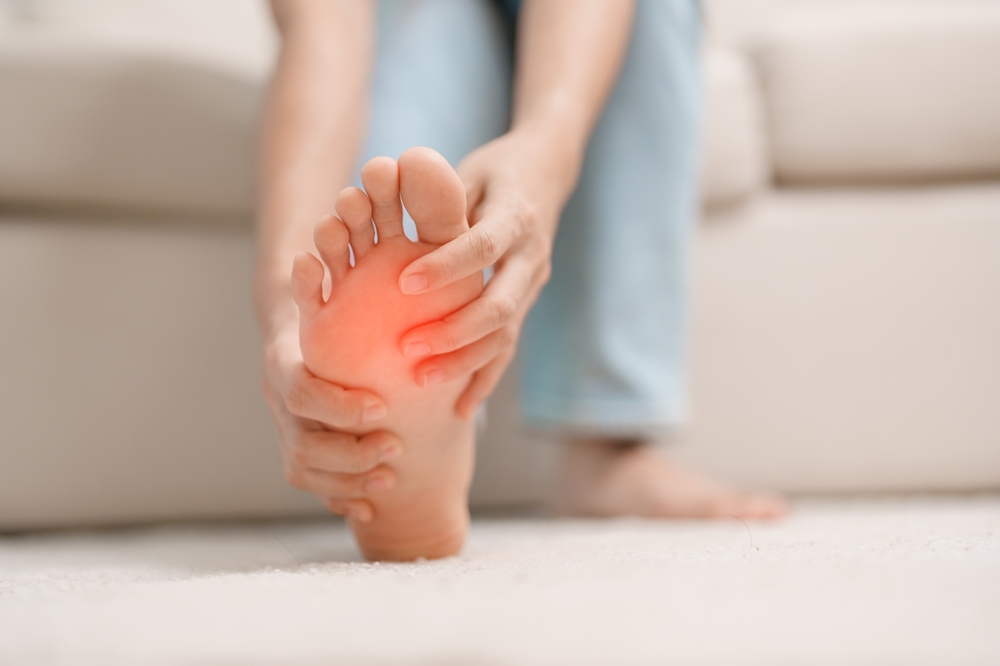You put a lot of pressure on your feet every day, and sometimes they ache. Here’s what you can do about it.
Your feet may be the hardest working joints in your body. The American Academy of Orthopaedic Surgeons reports that every mile you walk puts 60 tons of pressure on each foot, so it’s no surprise many people suffer from foot pain at some point in their lives that makes walking and doing everyday tasks difficult.
Yet, living with painful feet doesn’t have to hamper your lifestyle. Getting treatment as soon as the pain begins can relieve your aching feet and get the spring back in your step. In this article, we’ll explore the five most common foot ailments and their treatment options.
Five of the most common foot problems
Your foot is a complex structure of 26 bones, 33 joints, and more than 120 muscles, ligaments, tendons, and nerves. In light of how much stress your feet absorb daily, you’ll likely experience occasional foot pain. In fact, HealthyAging.org estimates that 87% of people will have an aching foot during their lifetimes, with one-third of older adults affected by foot pain.
Chances are your foot pain is related to one of these five common podiatric conditions, but luckily, most of these can be remedied without surgery.
Bunions. A bony protrusion on the side of the metatarsophalangeal joint connecting the big toe to the foot, a bunion causes pain and swelling that worsens without treatment. Bunions can be traced to several causes, including rheumatoid arthritis and a family history of the condition. Contrary to popular belief, bunions are not the result of ill-fitting shoes, but they can become more painful when wearing restrictive footwear.
Treatment: Conservative therapy options like switching to comfortable shoes, stretching and icing the painful toe, wrapping the toe in protective padding, and putting the toe in a splint can correct a bunion. If those methods don’t work, surgery to remove any growths and realign the toe may be recommended. After surgery, you’ll wear a boot and must keep the foot elevated. Recovery can take up to four months.
Hammertoes. A hammertoe is an abnormal bending of the middle joint of the toe caused by tight tendons, nerve damage, and possibly diabetes. Stubbing your toe or wearing high heels are common ways this condition develops. Hammertoes make walking painful, and if the curve rubs against the top of a shoe, it can lead to painful calluses and corns.
Treatment. Orthotics and toe-strengthening exercises are the first lines of treatment for hammertoes. Advanced cases of hammertoe may require toe-straightening surgery.
Plantar fasciitis. Often seen in runners, plantar fasciitis develops when the plantar fascia, a thick band of tissue running from the heel to the base of the toes, becomes irritated and inflamed from continual stress. Because the plantar fascia supports the foot arch, people with flat feet often develop this condition.
Treatment. Anti-inflammatories and physical therapy can usually resolve plantar fasciitis pain. If the condition fails to respond to conservative treatment, plantar fasciitis release surgery to remove damaged portions of the tissue may be the next step.
Fractures. With 26 bones, your foot is particularly vulnerable to fractures, from either repeated stress or an actual break. Pain when walking and bearing weight as well as a noticeable deformity in the foot signal a fracture.
Treatment. Keeping the foot immobilized in a cast until the bone heals is the standard treatment for foot fractures. More complex fractures may require surgery to repair.
Morton’s neuroma. A neuroma occurs when a portion of a nerve thickens. It’s often seen in the foot, causing pain in the ball of the foot, tingling or numbness in the toes, or a burning sensation in the foot or toes. Wearing high heels with pointed toes is one cause, but Morton’s neuroma can also result from a repetitive sports injury, such as the stress of regular running.
Treatment. Custom-made orthotics and anti-inflammatories can reduce the pain. If needed, a corticosteroid can be injected into the neuroma. It’s also advisable to switch to more comfortable, less restrictive footwear. Surgery to remove the irritated nerve is called for only if conservative methods fail.
Get back on your feet!
The podiatrists at New York Bone & Joint Specialists have the expertise to treat any foot issue. With proper diagnosis and a customized treatment plan, you’ll be walking pain-free again. Contact us for a consultation today.




